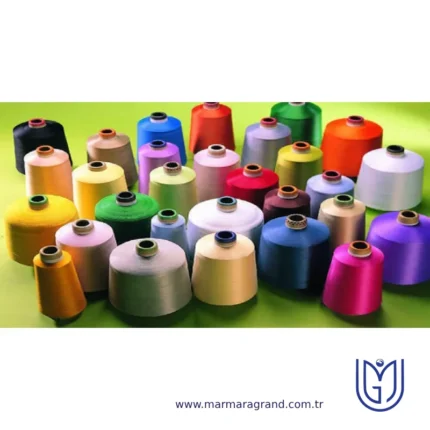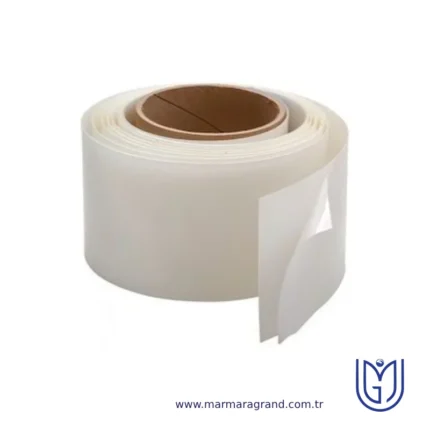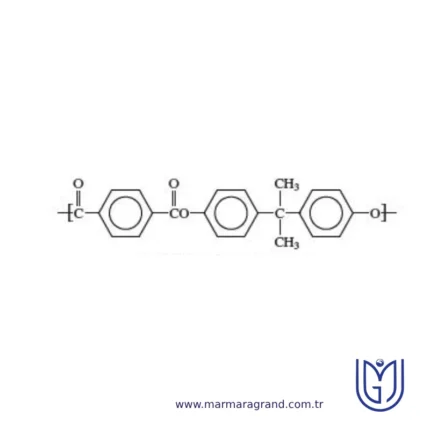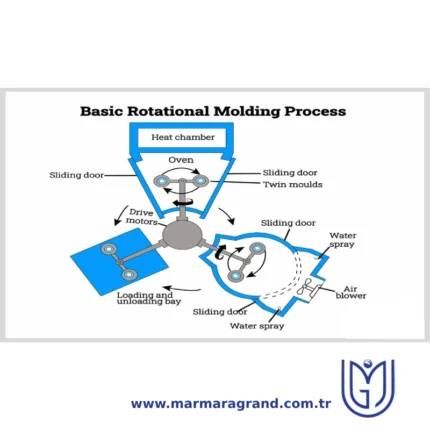Nylon 6-6
Nylon 66 is a type of synthetic polymer belonging to the nylon family of polyamides. It was first developed by Wallace Carothers and his team at DuPont in 1935. Nylon 66 is widely used due to its excellent mechanical properties, high thermal resistance, and chemical stability.
Structure
Nylon 66 is a synthetic polyamide with a repeating molecular structure formed through the condensation polymerization of hexamethylenediamine and adipic acid. The polymer consists of amide (-CONH-) linkages connecting alternating units of six carbon atoms from each monomer, resulting in a linear, highly ordered structure. This arrangement allows strong hydrogen bonding between polymer chains, enhancing its strength, rigidity, and thermal resistance. The repeating unit in Nylon 66 contains both aliphatic and amide groups, contributing to its balanced combination of flexibility and toughness. The presence of these intermolecular forces gives Nylon 66 its high melting point, excellent wear resistance, and mechanical stability, making it a widely used material in engineering and industrial applications.
Properties
Nylon 66 exhibits a combination of excellent mechanical, thermal, and chemical properties, making it highly suitable for various industrial applications. It has high tensile strength, toughness, and rigidity, which contribute to its durability and resistance to wear and abrasion. Its high melting point, typically around 255°C, allows it to maintain structural integrity under elevated temperatures. Nylon 66 also has good chemical resistance, particularly against oils, solvents, and many hydrocarbons, though it can absorb moisture, which may affect its mechanical properties. It has low friction and self-lubricating properties, making it ideal for applications requiring smooth movement and reduced wear. Additionally, Nylon 66 has good electrical insulation properties, making it useful in electrical and electronic components. Its ability to be easily molded and processed further enhances its versatility in manufacturing.
Applications of Nylon 66:
- Automotive parts such as gears, bearings, fuel lines, and radiator tanks
- Electrical and electronic components like connectors, cable ties, and insulators
- Industrial machinery components, including conveyor belts and mechanical fasteners
- Textiles and fibers used in carpets, ropes, parachutes, and outdoor wear
- Consumer goods such as sports equipment, kitchen utensils, and zippers
- Packaging materials, especially in films and coatings for food and medical applications
- High tensile strength and durability
- Excellent resistance to wear, abrasion, and impact
- High melting point and good thermal stability
- Good chemical resistance to oils, solvents, and hydrocarbons
- Low friction and self-lubricating properties
- Good electrical insulation properties
- Easily moldable and processable for various applications
- Absorbs moisture, which can affect mechanical and dimensional stability
- Can degrade under prolonged exposure to UV light without proper additives
- More expensive than other types of nylon, such as Nylon 6
- Can be attacked by strong acids and bases
Polyarylate (PAR)
Polyarylate (PAR) is a type of high-performance aromatic polyester known for its excellent thermal stability, mechanical strength, and resistance to chemicals and UV radiation. It is commonly used in engineering applications where durability and heat resistance are required.
Structure
Polyarylate (PAR) is a high-performance thermoplastic polymer composed of repeating aromatic ester units in its backbone. Its structure consists of aromatic rings (benzene) connected by ester (-COO-) linkages, giving it excellent thermal and mechanical properties. The presence of these rigid benzene rings enhances the polymer’s strength, dimensional stability, and resistance to heat and UV radiation. Unlike aliphatic polyesters, which have flexible carbon chains, the rigid aromatic backbone of polyarylates prevents easy molecular rotation, making the material more heat-resistant and mechanically robust. A common type of polyarylate is based on bisphenol A (BPA) and terephthalic or isophthalic acid, forming a polymer with a high glass transition temperature and excellent durability. This unique structure makes polyarylates ideal for applications requiring transparency, heat resistance, and chemical stability, such as optical lenses, automotive parts, and electronic components.
Properties
Polyarylate (PAR) exhibits a combination of high thermal stability, mechanical strength, and chemical resistance, making it a valuable engineering thermoplastic. It has a high glass transition temperature (Tg) of around 180°C, allowing it to retain its shape and strength under elevated temperatures. Its excellent mechanical properties, including high tensile strength and toughness, make it resistant to wear and impact. Additionally, PAR has outstanding UV and weather resistance, preventing degradation when exposed to sunlight, making it suitable for outdoor applications. The polymer is also chemically resistant to oils, acids, and solvents, ensuring durability in harsh environments. Many grades of polyarylate are optically transparent, making them useful for lenses and display applications. Furthermore, it exhibits good dimensional stability and low creep, ensuring reliability in precision applications like electronic components and automotive parts. These properties collectively make PAR an ideal material for high-performance applications where strength, heat resistance, and durability are essential.
Applications of Polyarylate (PAR):
- Electronics & Electrical Components – Used in connectors, insulators, and circuit boards due to its heat and electrical resistance.
- Automotive Parts – Ideal for components exposed to high temperatures and mechanical stress.
- Aerospace Industry – Used in structural components for its lightweight and high durability.
- Optical Lenses & Displays – Some grades are optically clear, making them suitable for eyewear, camera lenses, and LCD panels.
- Medical Devices – Resistant to sterilization methods and biocompatible for certain medical applications.
- Industrial Machinery – Used in gears, seals, and mechanical components requiring high strength and wear resistance.
- Consumer Goods – Found in high-end cookware, protective coatings, and UV-resistant outdoor products.
- High heat resistance – Maintains strength at elevated temperatures.
- Excellent mechanical strength – High tensile strength and impact resistance.
- UV and weather resistance – Ideal for outdoor applications without degradation.
- Good chemical resistance – Withstands exposure to oils, acids, and solvents.
- Optical clarity – Some grades are transparent, useful for lenses and displays.
- Dimensional stability – Low creep and high rigidity for precision applications.
- Expensive – Higher cost compared to conventional plastics.
- Difficult processing – Requires specialized equipment and high processing temperatures.
- Brittle in some conditions – May be prone to stress cracking under certain loads.
- Limited availability – Less commonly used than other engineering plastics, leading to fewer commercial grades.
Rotational Molding
The rotational molding process is a straightforward yet effective method. In this technique, a plastic material, typically in powdered form, is placed inside a hollow mold. This mold is usually made of cast aluminum or fabricated from sheet steel. Once sealed, the mold rotates slowly around two axes. Simultaneously, it is heated inside an oven while continuously rotating. As the temperature rises, the plastic powder melts and evenly coats the inner surface of the mold. When the plastic has completely liquefied, the mold is transferred to a cooling station, where it is cooled using air or occasionally a fine mist of water. During this phase, the plastic gradually solidifies and takes its final shape. Once the material has cooled sufficiently and detaches from the mold’s surface, the process is halted, and the finished product is removed from the mold.
Types of rotational moldingClamshell Rotational Molding
- Uses a single-arm machine with an oven and cooling chamber combined.
- Best for smaller production runs or prototyping.
- Less efficient than multi-arm machines but requires less space.
- Designed for long and narrow products like kayaks and boats.
- The mold rotates on one axis while rocking back and forth on another axis.
- Ideal for making large, elongated parts with uniform wall thickness.
- Features two arms that shuttle between heating and cooling stations.
- Allows simultaneous molding and cooling, increasing production efficiency.
- Suitable for medium to large-scale manufacturing.
- Uses a vertical rotation system rather than the traditional horizontal axis.
- Provides more control over material distribution.
- Less common but useful for specific applications requiring precise thickness control.
- The most common and efficient type, often with three to four arms.
- Molds move continuously between loading, heating, cooling, and unloading stations.
- Ideal for high-volume production and large-scale manufacturing.
Advantages of rotational molding
- Cost-Effective Tooling – Molds are cheaper compared to injection or blow molding.
- Uniform Wall Thickness – Ensures even material distribution with no weak spots.
- Seamless and Hollow Structures – Produces one-piece parts without welds or joints.
- Design Flexibility – Allows for complex shapes, undercuts, and integrated features.
- Strong and Durable Products – High impact resistance with reinforced corners.
- Wide Range of Materials – Can use polyethylene (PE), polypropylene (PP), and nylon.
- Minimal Material Waste – Excess plastic can be recycled and reused.
- Large Part Capability – Ideal for tanks, containers, and oversized plastic products.
- Consistent and Repeatable Process – Ensures uniformity in mass production.
- Eco-Friendly Process – Lower energy consumption and recyclable materials.
Disadvantages of rotational molding
- Longer Cycle Times – Slower process compared to injection or blow molding.
- Higher Material Costs – Limited to specific thermoplastics, which can be more expensive.
- Limited to Hollow Parts – Not suitable for solid or highly detailed small components.
- Lower Precision and Tolerance – Less accuracy in dimensional control compared to injection molding.
- Limited Automation – More labor-intensive, leading to higher production costs for large runs.
- Surface Finish Limitations – May require post-processing for a smooth or polished surface.
- Lower Production Efficiency – Not ideal for high-volume production due to longer cycles.
- Thicker Walls Required for Strength – Thinner-walled parts may lack the necessary strength.
- Cooling Time Can Be Long – Extended cooling periods increase overall production time.
Applications of rotational molding
- Storage Tanks – Water tanks, fuel tanks, and chemical storage containers.
- Automotive Parts – Fuel tanks, air ducts, mudguards, and fenders.
- Industrial Containers – Bins, hoppers, and transport containers.
- Playground Equipment – Slides, climbing structures, and outdoor playsets.
- Furniture – Modern plastic chairs, tables, and decorative items.
- Marine & Boating – Kayaks, canoes, buoys, and dock floats.
- Medical Equipment – Enclosures, casings, and patient support devices.
- Agricultural Products – Feed storage bins, water troughs, and irrigation tanks.
- Recreational & Sports Gear – Helmets, cones, and protective padding.
- Road & Traffic Safety – Barriers, traffic cones, and road markers.
- Consumer Goods – Coolers, toolboxes, and custom cases.











